Discovering Walruses
Air Date: Week of August 20, 2010
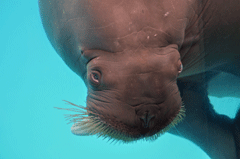
Sivuqaq the walrus might not look like the musical type, but his trainers know better. (Photo: Nancy Chan, Six Flags Discovery Kingdom)
Not much is known about the walrus since the animals inhabit some of Earth’s most remote places. But researchers are beginning to observe some remarkable things about walrus behavior: not only are they very musical, but they are also very gregarious and sexual. Matthew Brunwasser reports.
Transcript
YOUNG: The walrus is one the world's most mysterious mammals. Its habitat is less than hospitable for researchers. Much of what scientists do know about them comes from the native people who hunt them. One very little known fact is that walruses are musical -- their songs are some of the longest and most complex in the animal kingdom. Now climate change is adding urgency to walrus research.
In Vallejo, California, researchers hope the secrets of walrus breeding songs can help preserve the species. Matthew Brunwasser reports – and a warning—Matthew’s report has some frank descriptions of walrus reproduction.
[WALRUS ROAR]
BRUNWASSER: Now is a trying time to work at the walrus tank at the Six Flags theme park. Trainer Toni Rael introduces me to Sivuqaq, a 2,400 pound male pacific walrus who lives here. He’s about the size of a Honda Civic. Rael says he is being obnoxious, like a guy in a bar.
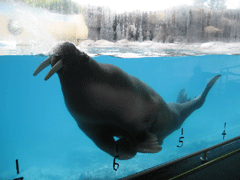
Sivuqaq in his tank. (Photo: Matthew Brunwasser)
RAEL: Well Sivuqaq thinks it breeding season. So right now, he is in his rut, male walruses go thru a rut behavior where they will make a lot of different vocals to solicit females and try to get the girls’ attention. However, the females have already been through their cycle and are no longer in season, so they’re done with him. [laughs]
[WALRUS ROAR]
RAEL: So now he’s soliciting everyone else he can find. [laughs]
BRUNWASSER: The park is trying to breed Sivuqaq with its two female walruses. But no luck so far. Rael says they haven't quite figured out how to get him in the mood at the same time as the females. He also seems a bit confused.
RAEL: Strange things at different times seem to get him excited. He seems to like anything at the lower windows. We have had a new recycle bin that we put at the window; he really liked that for awhile. Anything different, strollers, people, anything power-tool related.
[SPLASHING SOUND; WALRUS ROAR]
BRUNWASSER: Sivuqaq and the two females came to the park when they were only a few months old, after being orphaned in a hunt in Alaska. All are unrelated. And none grew up with adult walruses. So their behavior is an ad hoc mix of instinct and learning in captivity. Holley Muraco is a reproductive physiologist researching walruses at the park. She says little is known about walrus breeding in general.
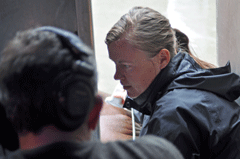
Holley Muraco does ultrasound on a female walruses, checking her ovaries. (Photo: Nancy Chan, Six Flags Discovery Kingdom)
MURACO: There’s only been ten walrus calves ever born in zoological facilities, so that's pretty significant. They are very sexual animals, they live long lives in zoos, but for some reason we not getting a lot of babies. So clearly something is missing.
BRUNWASSER: Muraco says weather, temperature and sunlight could be factors, since the Bay Area is mild year-round. She is also checking hormones, and monitoring body fluids regularly, in both Sivuqaq and the females, to find the triggers for their breeding behavior. She says she wants to collect the first walrus sperm sample ever taken. A healthy batch would be valuable for study and could also be used to artificially inseminate one of the females. She holds up a special tube-shaped instrument.
MURACO: This is the artificial vagina, and it's basically a PVC pipe. It has got thick rubber on either end of it, so that there’s no sharp edges. We will train him to put his penis inside there and hopefully we will figure out what exactly the trigger is that’s going to make him feel comfortable enough to give us a sample.
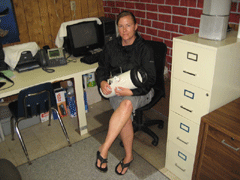
Reproductive physiologist Holley Muraco, with the artificial walrus vagina. It has a handle and a valve so it can be filled with warm water. (Photo: Matthew Brunwasser)
BRUNWASSER: The park will then build a mount for the artificial vagina and hope that Sivuqaq takes a liking to it. There are still many surprises when you are dealing with walrus sexuality. The walrus, like many mammals, has a baculum, or penile bone. Researchers say it's an impressive sight.
MURACO: It's about three feet long. The native people use the walrus penis bone as walking sticks, they use them as clubs, in the past. And it’s a pretty remarkable, definitely a pretty remarkable structure.
[WALRUS ROAR]
BRUNWASSER: Another extraordinary attribute of male walrus behavior is their musicality. Through a viewing window, research biologist Colleen Reichmuth is observing and filming Sivuqaq’s displays and vocalizations underwater.
REICHMUTH: Three, two, one, go
[KNOCKING SOUNDS]
REICHMUTH: This is Sivuqaq track number three. He’s at two and a half meters, head up, filling the sacks, producing some bell-like sounds, moans at two and a half, double knock, some low amplitude moans.
BRUNWASSER: Reichmuth is gauging the strength of Sivuqaq’s sounds.
[WALRUS MOANS]
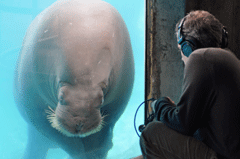
Reporter Matthew Brunwasser records Sivuqaq. (Photo: Nancy Chan, Six Flags Discovery Kingdom)
BRUNWASSER: He claps his flippers in the water as part of his display. You can hear it loudly even through the 4-inch thick window of the tank. Here it’s also amplified through a speaker.
REICHMUTH: You know, walruses are some of the most amazing animal in terms of their acoustics because they can make sounds with all different parts of their body.
BRUNWASSER: Walruses are piniped beatboxes, clapping, moaning, whistling and making bell sounds with an air sack in their necks.
REICHMUTH: An important sound that we should hear today is called the knock. It’s a really loud knocking noise he is making inside his forehead without releasing any air. And we’re not really sure, you know, how he is manipulating his anatomical structures to make such a loud noise.
[WALRUS KNOCKING]

Sivuqaq the walrus might not look like the musical type, but his trainers know better. (Photo: Nancy Chan, Six Flags Discovery Kingdom)
BRUNWASSER: To try to find out, Reichmuth rejoins Sivuqaq face to face upstairs. Leah Coombs is a master walrus trainer, has known Sivuqaq since he was a baby.
[WALRUS KNOCKING]
COOMBS: Knock, knock, good.
[WALRUS KNOCKING]
BRUNWASSER: Reichmuth puts her hand into his mouth to try to feel where the sounds are coming from. The display is followed by a surprise blown from his nose.
[THE SOUND OF A WALRUS EXPELLING SNOT]
COOMBS: What is that?!
[LAUGHTER]
BRUNWASSER: Sivuqaq is clearly still learning to sing. In the wild, the knocks of male walruses are far more developed.
[WALRUS KNOCKING]
BRUNWASSER: This might sound like a German industrial band from the 1980s. But this is a wild walrus, recorded in the Canadian high arctic. Underwater. The sounds are so loud and sharp they can be heard above the sea ice and underwater more than 5 miles away.
[WALRUS KNOCKING]
BRUNWASSER: This medley of breeding sounds includes knocks and bells.
[WALRUS KNOCKS AND BELLS]
BRUNWASSER: Scientists can only hope they figure out these mustachioed enigmas quickly enough to keep up with the pace of arctic climate change. Joel Garlic-Miller is a walrus biologist at the U.S. Fish and Wildlife Service in Anchorage. He says a warming Arctic is bad news for walruses because they prefer to live on floating sea ice.
GARLIC-MILLER: If you look at long-term data sets of sea-ice thickness and extent, we’ve seen some very substantial declines in both the area covered by sea ice and sea ice thickness over the past 20 years.
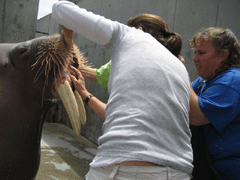
Reichmuth tries to feel where the knocking comes from in Sivuqaq’s head by putting her hand in his mouth.
BRUNWASSER: When the sea ice disappeared in the summer of 2007, thousands of walruses hauled up on the Alaska coast for the first time. The skittish animals have no experience with people, cars or airplanes, and are prone to stampeding and trampling, which can kill juveniles. Wild walruses are almost never seen by humans, unlike polar bears, which live close enough to people to eat from their garbage cans. Garlic-Miller says no one has ever been able to count how many walruses there are.
GARLIC-MILLER: They inhabit a vast, remote inaccessible habitat. Probably the most remote area on the planet and most difficult to access. Shifting sea ice, over thousands and thousands of square miles, many hundreds of miles offshore is where they prefer to distribute themselves.
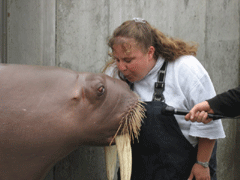
Walruses like it when you blow in their nose; this is how they “meet” each other. (Photo: Nancy Chan, Six Flags Discovery Kingdom)
BRUNWASSER: So U.S. and Russian scientists began the first serious population survey of the Pacific walrus in 2006. The findings should be ready soon.
GARLIC-MILLER: It's been quite a challenge to get some very basic biology about them.
BRUNWASSER: Walruses are not currently listed as threatened or endangered. But due to diminishing sea ice, U.S. Fish and Wildlife was petitioned to consider listing them. A decision is expected in the fall of 2010.
For Living on Earth, I’m Matthew Brunwasser, in Vallejo, California.
YOUNG: Since this story first aired the large male walrus at Six Flags Discovery Park has undergone fertility treatment to get him in sync with the females’ cycles… and it appears to be a success! Although she won’t know for sure until sometime this fall, Holley Muraco says she’s hopeful that one of the female walruses is already pregnant.
Living on Earth wants to hear from you!
Living on Earth
62 Calef Highway, Suite 212
Lee, NH 03861
Telephone: 617-287-4121
E-mail: comments@loe.org
Newsletter [Click here]
Donate to Living on Earth!
Living on Earth is an independent media program and relies entirely on contributions from listeners and institutions supporting public service. Please donate now to preserve an independent environmental voice.
NewsletterLiving on Earth offers a weekly delivery of the show's rundown to your mailbox. Sign up for our newsletter today!
 Sailors For The Sea: Be the change you want to sea.
Sailors For The Sea: Be the change you want to sea.
 The Grantham Foundation for the Protection of the Environment: Committed to protecting and improving the health of the global environment.
The Grantham Foundation for the Protection of the Environment: Committed to protecting and improving the health of the global environment.
 Contribute to Living on Earth and receive, as our gift to you, an archival print of one of Mark Seth Lender's extraordinary wildlife photographs. Follow the link to see Mark's current collection of photographs.
Contribute to Living on Earth and receive, as our gift to you, an archival print of one of Mark Seth Lender's extraordinary wildlife photographs. Follow the link to see Mark's current collection of photographs.
 Buy a signed copy of Mark Seth Lender's book Smeagull the Seagull & support Living on Earth
Buy a signed copy of Mark Seth Lender's book Smeagull the Seagull & support Living on Earth

